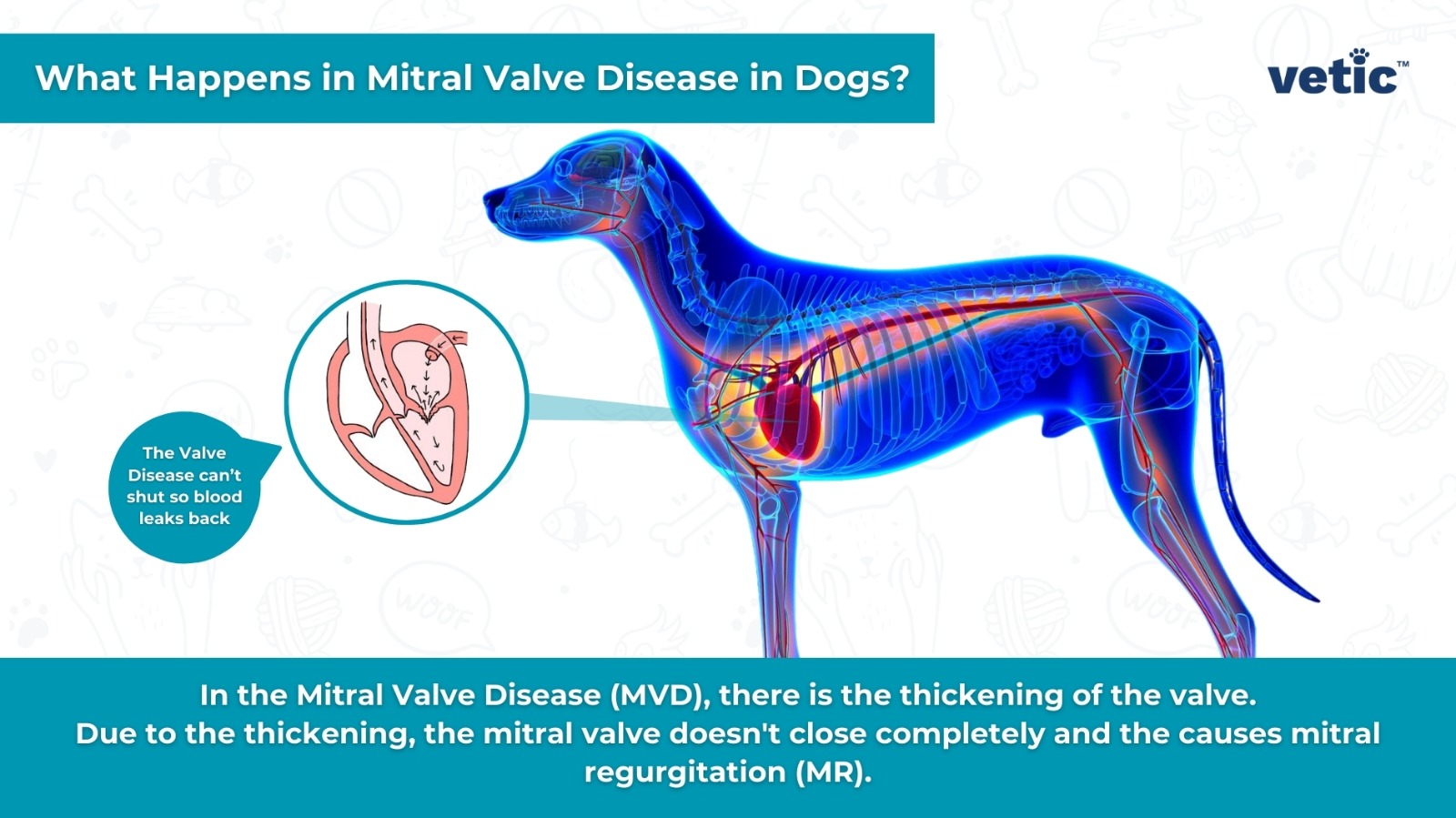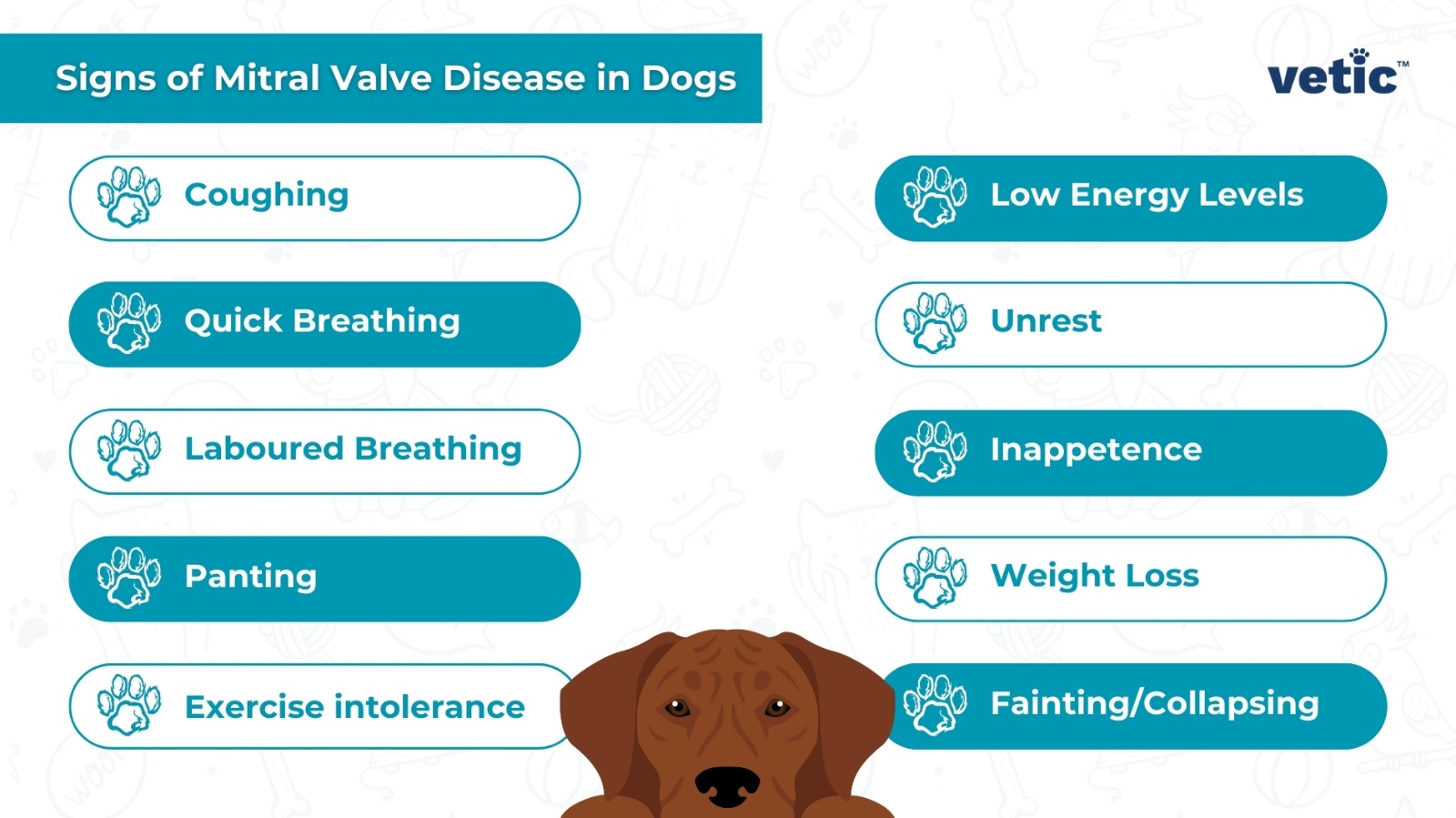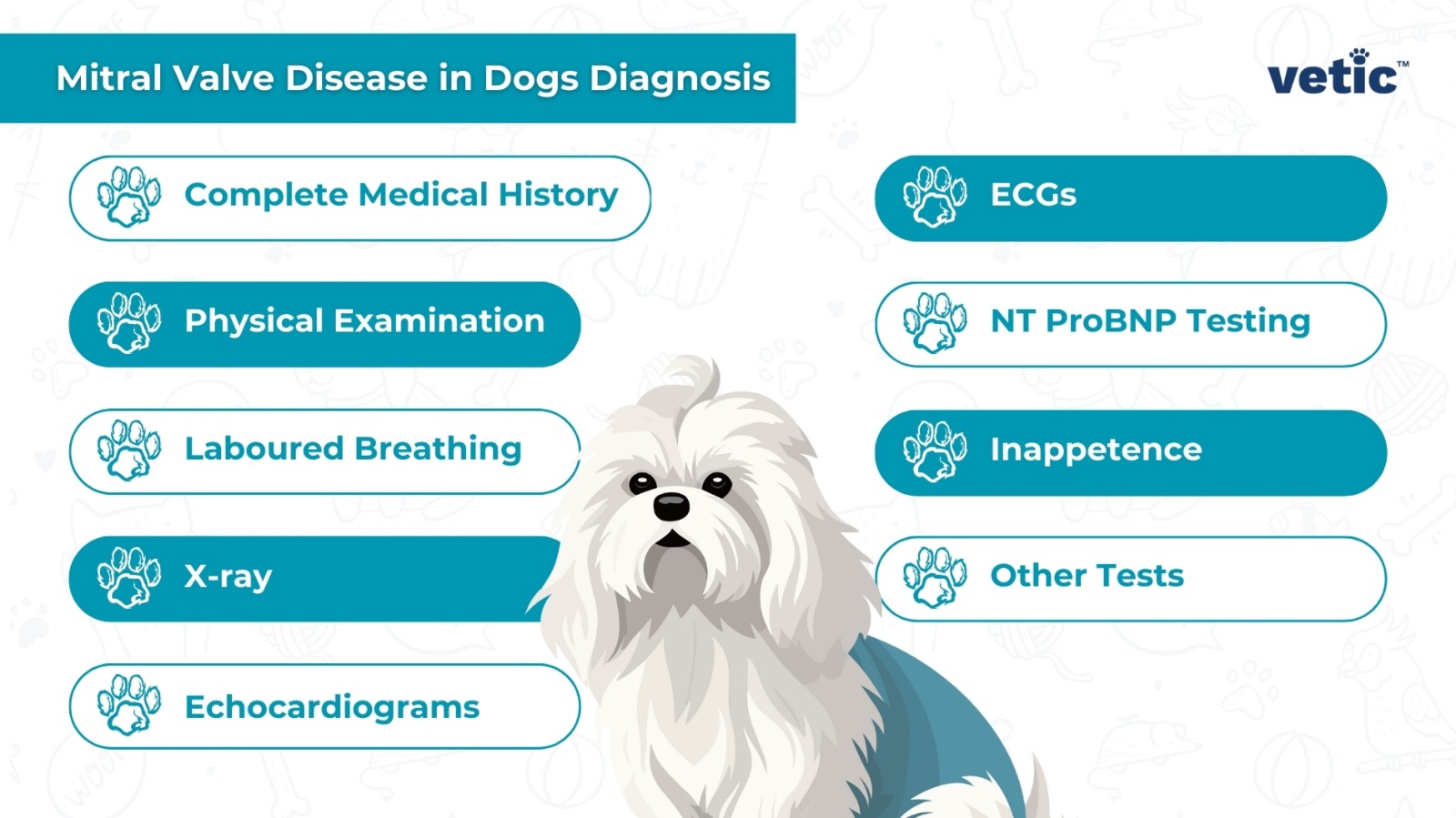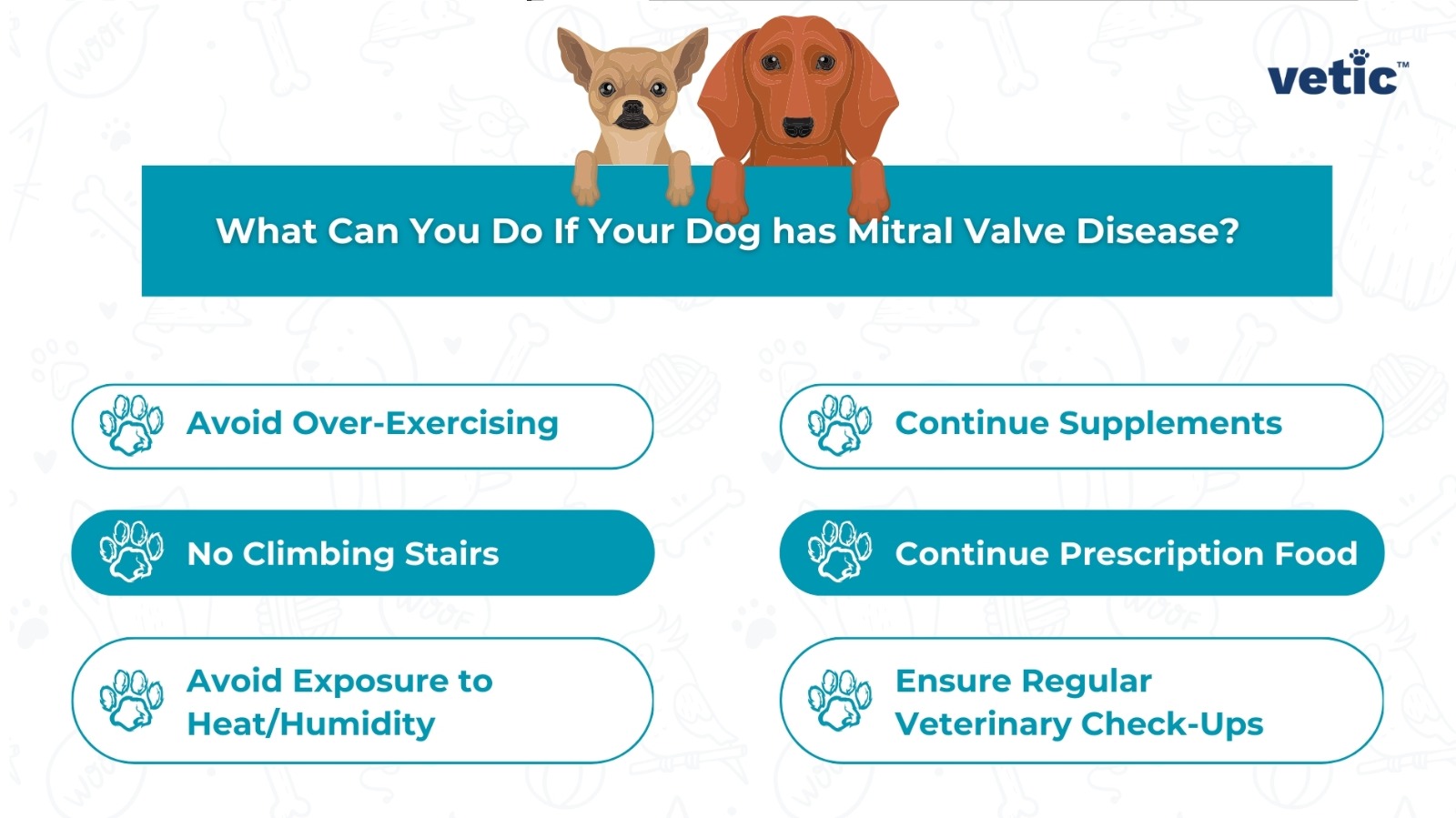What is the Mitral Valve?
Mitral valve is a one-way flap-like structure that allows the blood to flow from the upper left chamber (left atrium) to the lower left chamber (left ventricle) of the heart.
The function of the mitral valve is to prevent the (reverse) flow of blood from the left lower chamber to the upper chamber.
The mitral valve is a very thin structure made of two flaps or cusps. So, it’s also called the bicuspid valve.
What Happens in Mitral Valve Disease in Dogs?

In the Mitral Valve Disease (MVD), there is the thickening of the valve. Small nodules form on the edges of the flaps. Due to the thickening, the mitral valve fails to close completely and the blood from the lower chamber of the heart flows back to the upper chamber. This is known as mitral regurgitation (MR).
It is a degenerative disease, also known as Degenerative Mitral Valve Disease (DMVD). Over time, the size of both the left chambers increase and the valve continues to thicken. As the leak worsens, signs of congestive heart failure (CHF) begin to show.
Degenerative Mitral Valve Disease (DMVD) in dogs is also known as canine myxomatous mitral valve disease.
How common is mitral valve disease in dogs?
10% of all domestic dogs develop some heart disease during their lifetime.
80% of the heart diseases in dogs develop due to the degeneration of the mitral valve or mitral valve disease.
Mitral valve disease is more commonly seen among male dogs as compared to female dogs.
Which Dog Breeds are at a Higher Risk of Developing Mitral Valve Disease?

Mitral valve disease does affect a small percentage of large dog breeds, but it’s oddly prominent in the small dog breeds whose adult weight is below 9 kg.
Mitral disease in dogs depends upon genetics. So, some dog breeds are at higher risk of developing DMVD as compared to other breeds.
Here are some small dog breeds prone to mitral valve disease –
- Miniature Poodles
- Shih Tzu
- Maltese
- Dachshunds
- Whippets
- Chihuahua
- Pomeranians
Sadly, the disease is caused by a mutation that dogs can inherit from either of their parents. There is nothing you can do to prevent it. However, preventive check-ups every 6 months can help in the early detection and management of the diseases in high risk breeds.
What are the Signs of Mitral Valve Disease in Dogs?
In the early stages of mitral valve disease in dogs, the signs will be very subtle. As the degeneration of the mitral valve progresses, the signs become more pronounced.

The signs of mitral valve disease in dogs include –
- Coughing (after lying down, often worsens at night)
- Quick breathing
- Laboured breathing
- Panting
- Exercise intolerance
- Low energy levels
- Unrest
- Inappetence
- Weight loss
- Fainting and collapsing
How is Mitral Valve Disease in Dogs Diagnosed?

Complete medical history
Your vet will require the complete medical history of your dog including any infections, changes in breathing or cough, and changes in behaviour patterns that may indicate degenerative mitral valve disease.
Physical examination
The first sign a veterinarian looks for is a heart murmur. It is the earliest sign of mitral valve disease in dogs.
X-ray
An X-ray of the chest is necessary for checking the size and health of the heart. It can also indicate the presence of any fluid in the chest cavity.
Echocardiograms
An echocardiogram helps in “constructing” the image of the heart complete with the heart muscles, valves and heart function. It is currently considered one of the most efficient ways to detect mitral valve disease in dogs in India.
ECGs
ECGs or electrocardiograms can detect any abnormalities in the activity of the heart including arrhythmias.
NT ProBNP testing
Vets can recommend testing of blood samples to detect strain on the heart muscles. High results indicate the presence of mitral valve disease in dogs.
Other tests
The veterinarian will also likely recommend complete blood count (CBC), biochemistry tests to see kidney and liver functions, and complete urinalysis. These tests are especially necessary if the dog is on medication for other health problems.
What’s the Treatment for Mitral Valve Disease in Dogs?
Sadly, mitral valve disease in dogs is not curable. It is a chronic degenerative disease. That means, the mitral valve health continues to worsen over time.
Medical management
Medicines for mitral valve disease in dogs will depend upon the stage they are in. Sometimes, dogs might require diuretics that remove the fluid from their chest cavity to help reduce the pressure on the heart and allow them to breathe better.
Medicines for strengthening the heart muscle and improving their function are most commonly prescribed by veterinary cardiologists.
Other medications may include those that protect the kidneys from the secondary effects of heart disease and control the blood pressure.
Supportive care
The dogs that are stable on oral medication can stay at home and continue with their life. However, they will require plenty of rest and low exercise levels.
If your dog is on medication for mitral valve disease, give them plenty of clean water for drinking, avoid all types of salty food and commercial dog food, give them vet prescribed supplements and prescription food only.
However, dogs in Stage D of the disease may require oxygen support and 24×7 in-patient care until their health condition stabilises.
What Can You Do If Your Dog has Mitral Valve Disease?

While mitral valve disease in dogs isn’t curable, you can always make a few changes around the house to make them more comfortable.
- Make sure your dog doesn’t climb stairs frequently or run around for long periods of time.
- Always keep fresh water available for your dog when they are on supportive medication.
- Keep your eyes out for excessive coughing and wheezing that doesn’t improve after medication.
- Keep your dog out of hot and humid conditions to help ease their breathing.
- Give prescription heart food to your dog as per the recommendation of your veterinarian.
- Do not miss medicine doses, alter medicines or change their dose frequency without consulting your vet.
- If you see any signs of concern, you need to contact your veterinarian immediately.
- Keep the details of an emergency veterinary clinic with oxygen support facility for urgent care.
How Long Can a Dog with Mitral Valve Disease Survive?
The prognosis of mitral heart disease depends upon the breed of your dog and the stage of MVD. Some dogs who are not genetically predisposed and have developed mitral valve disease in their old age, may survive for over 3-5 years after diagnosis on proper supportive medication.
The smaller breeds who are genetically predisposed to degenerative mitral valve disease typically have lower median life expectancy after diagnosis (12 to 18 months).
Nonetheless, the prognosis will depend upon the right diagnosis, medical management and supportive therapy your dog receives.
